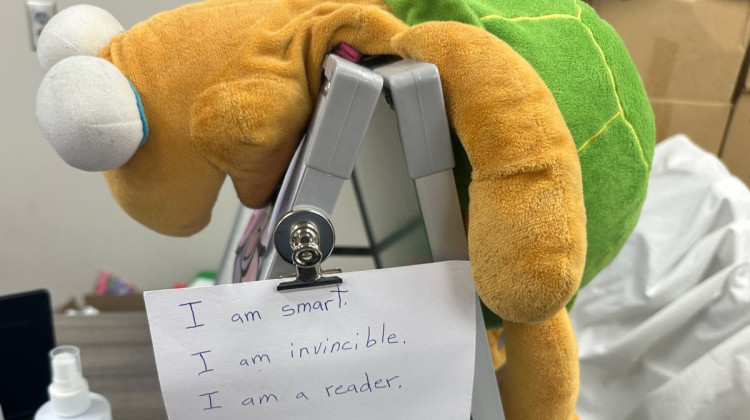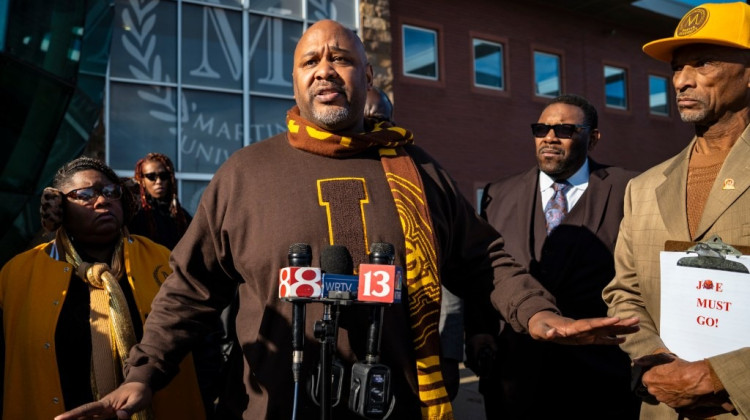
Beech Grove, Wayne, Franklin, Lawrence, Perry, and Decatur townships are all instituting price increases at their preschools.
Jimena Peck for ChalkbeatSign up for Chalkbeat Indiana’s free daily newsletter to keep up with Indianapolis Public Schools, Marion County’s township districts, and statewide education news.
Sheretta McCoy sends her 4-year-old to preschool because she wants him to be prepared for kindergarten.
As a teacher, she believes education is important. Plus, she needs somewhere to send her son while she works. But it’s not as easy as just dropping her son off and picking him up daily. She also has to figure out how to fit preschool into her family budget.
“Because prices keep going up on everything and my pay is not going up, it’s a struggle to pay for day care each week,” she said.
McCoy is not alone. Preschool costs are on the rise in Marion County, leaving many families to wonder how they will afford the crucial service. At least seven public school districts in the Indianapolis area are raising the cost of preschool for the coming year, as the state makes cuts to its state preschool voucher program, On My Way Pre-K.
MORE Indiana slashes number of children in state preschool program
Beech Grove, Wayne, Franklin, Lawrence, Perry, and Decatur townships are all instituting price increases at their preschools. Some raised their tuition by as little as $5 while others bumped prices by $60. Wayne Township did not respond to a request about the amount its cost is increasing.
Indianapolis Public Schools, meanwhile, is introducing sliding-scale tuition, citing cuts to On My Way Pre-K and the loss of federal Covid funds. All children previously attended for free, but now families who do not qualify for aid will pay the full price of $150.
Washington and Pike Township are keeping their rates the same, while Warren did not respond to a request about whether it was changing its cost.
Indiana caps enrollment, cuts funding for pre-K program
IPS attributes the switch to a paying model partly to changes to the preschool voucher program.
On My Way Pre-K helps low-income families afford preschool for their 4-year-olds. Under the program, low-income families receive vouchers to pay for preschool.
But new rules significantly limit the size and scope of the program.
According to the Family and Social Service Administration, in the 2024-2025 school year, over 6,000 children received On My Way Pre-K vouchers. This year, however, enrollment is capped at 2,500 seats.
Additionally, the voucher amount is now lower. Previously, preschool programs could receive over $300 per week from On My Way Pre-K. Now, coverage is capped at roughly $148 per week. Families will be responsible for covering the cost of preschool tuition past that number.
Eligibility has also changed. To be eligible, families must make 140% of the federal poverty level or less, down from the previous 150%. Parents must be working, in school, or attending job training — those searching for a job are no longer eligible.
End of federal COVID funds affect preschool costs
Changes to On My Way Pre-K hit some districts harder than others. While some districts, such as IPS, rely on On My Way Pre-K for much of their funding, others have only a few families enrolled using the voucher program. Their tuition increases can be attributed to a variety of other factors.
Beech Grove was planning to raise its preschool tuition by $60 even before the changes to On My Way Pre-K.
“Last year we lost money on snacks in the first semester, and in the second semester we relied on weekly donations from the same 5–8 families,” Rob Adamson, principal of Beech Grove’s Hornet Park Early Childhood Center, told Chalkbeat in an email. “This created an unfair burden on them, so we needed to adjust our rates to cover the cost of snacks.”
Districts were also hit hard by the end of federal COVID aid.
In 2020, Congress created the Elementary and Secondary School Emergency Relief Fund. Indiana received about $2.8 billion from this fund. The infusion of money allowed many preschool programs to avoid raising their rates, even as labor, food, and supply costs rose.
IPS, for example, allocated nearly $18 million of the ESSER money it received to shielding preschool staff and classrooms from cuts.
But since that funding expired, programs are faced with tossing that increased price tag back onto parents.
“We are here to serve our public, our township people, but we also have to self-sustain,” said Nichole Webb, Director of Early Learning at Franklin Township Community Schools.
She cited rising cost of labor and certifications as part of the reason for her district’s price increase.
Pandemic money also allowed the On My Way Pre-K program to expand and educate additional children. Funding from a federal program called the Child Care and Development Fund, which helps low-income families pay for child care for children up to age 12, has helped pay for On My Way Pre-K since 2017. During the pandemic, CCDF expanded.
However the state will stop using CCDF to help support On My Way Pre-K, due to a reduction in available federal funding.
Preschool has academic benefits for kids
Rising costs and fewer vouchers could shut some families out of the market for preschool.
Brighter Futures Indiana found that the average weekly cost of full-time care for 4- and 5-year- olds in Marion County is about $195, higher than the Indiana average of $180. Early Learning Indiana’s Closing the Gap report found that care for one child costs on average 14% of a Marion County family’s income, with costs increasing for families with multiple children.
Capacity is also a concern. Despite high demand, as prices rise and the number of vouchers decrease, preschools and early child learning centers may find themselves with empty seats, said Maureen Weber, Early Leaning Indiana’s president. This could lead to the closure of programs, plunging the state deeper into a childcare deficit.
But to Weber, early childhood education is one of the most crucial investments Indiana could make, especially to help “level the playing field” for children from low-income backgrounds in core academic subjects and other skills.
She cited statistics that show that early childhood education improves children’s academic performance once they enter the K-12 system. One recent study found that children who attended preschool were more likely to attend college.
“Roughly one-third of our third graders passed both the math and language arts components of the ILEARN assessment,” Weber said, referring to results from the state’s standardized test. “I just think if our state is serious about making sure we’re competitive in the long run, we have to think differently about how we invest in vulnerable young families.”
Samantha Camire is a summer reporting intern covering education in the Indianapolis area. Contact Samantha at scamire@chalkbeat.org.
Chalkbeat is a nonprofit news site covering educational change in public schools.
 DONATE
DONATE






 Support WFYI. We can't do it without you.
Support WFYI. We can't do it without you.